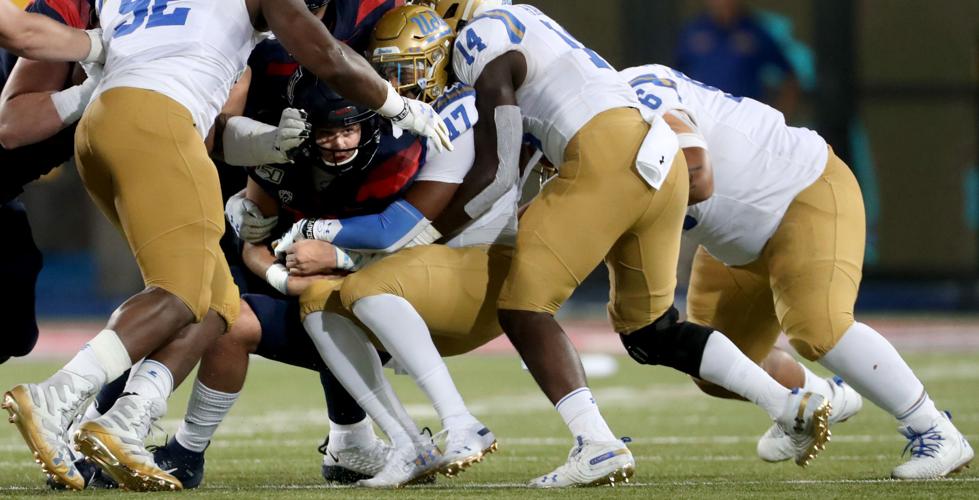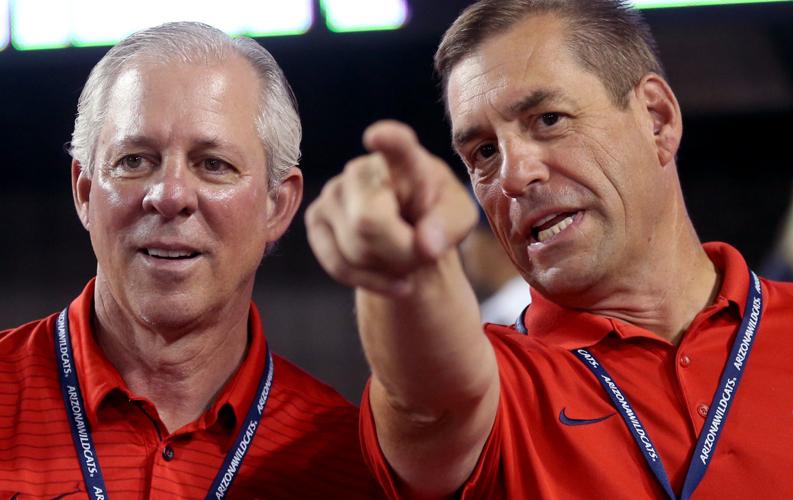Two men from a Phoenix workshop spent much of the week refurbishing and refitting the bowl-game ring of honor at Arizona Stadium, junking the faded red panels that said "Salad Bowl 1949" and "Foster Farms Bowl 2017" and everything in between.
The spiffed-up list of UA bowl games is now 100 yards long, fresh and more readable, with a deep blue background and white lettering. The workers were so generous in spacing out the 21 bowl placards that only three slots remain.
So you ask: How long will it take Arizona to fill those three spaces?
Maybe not as long as feared.
Arizona beat UCLA 20-17 Saturday night when true freshman quarterback Grant Gunnell threw for 352 yards with no interceptions in the most promising debut by an Arizona freshman QB since Willie Tuitama helped to stun Oregon State in 2005.
No, UCLA isn’t good at all. But a year ago on the same date, Sept. 28, Gunnell was quarterbacking Houston's St. Pius X High School against Prestonwood Christian High — and he lost 57-48.
Just when you least expected it, the Wildcats seem to have a promising future.
If UA coach Kevin Sumlin chooses to stick with Gunnell over injured starter Khalil Tate, it won’t be an end as much as it a beginning — although typical of the UA’s long-suffering football history. It’s probably going to be a bit before the Wildcats can feel secure about filling those empty bowl slots on the east side of Arizona Stadium.
When Tom Tunnicliffe (1980), Ronald Veal (1987), Kris Heavner (2003), Tuitama (2005) and Khalil Tate (2016) were forced via injuries or ineffective QB play to start in their true freshman seasons, it led to better football.

Arizona QB Khalil Tate burst into prominence at Colorado in 2017. Will he be able to play there Saturday?
But it was a painful transition. Those five UA teams finished a combined 17-37-3 with no bowl games. All but Heavner ultimately led Arizona to a bowl game.
So there’s that.
If Gunnell remains Arizona’s starting quarterback it’s about 50/50 Arizona will break .500 this season, but remember this: Tate was 8-12 in his last 20 starts. What does the UA lose by giving Gunnell as much time in 2019 as possible?
This "starting over" mentality isn’t new within the UA athletic department.
Athletic director Dave Heeke has a 35-page "Strategic Plan" for the future. It is the culmination — "a living document," he called it — of a two-year process in which more than 160,000 UA students, donors, administrators, employees and fans were consulted about the future of Arizona sports.
Why now?
"I don’t think (the athletic department) was firing on all cylinders," Heeke said with some frankness about his arrival in the spring of 2017.
The operative words used on Heeke’s five-pillar strategy are: "I am. I can. I will."
On Saturday night, behind Gunnell, it was more like "we did."
Heeke plans to introduce his strategic plan this week and make public "how we’re going to move forward." His goal is for 70 percent of the UA’s sports teams to qualify for NCAA tournament competition each year.
Those who follow Pac-12 sports know that it’s much easier said than done. Stanford, UCLA, USC, Cal and Oregon are giants in the NCAA’s comprehensive Director’s Cup standings, which measures success in all sports.
It’s difficult enough to make a move up in Pac-12 tennis and track and swimming, let alone football. Ask yourself: who’s moving down?
The over-arching goal is, Heeke said, "to solidify Arizona as a leader in the Pac-12 and NCAA. … we’re not going to get lapped."
That was more easily said 20 years ago, when Arizona was a true top 10 program in Director’s Cup measurements. But for about two decades, the Wildcats have been treading water — surviving, growing debt — as not-so-sexy schools such as Minnesota, Wake Forest and Maryland surpassed Arizona (No. 41 last season) in the Director’s Cup.
Much of what Heeke and his steering committees propose are inspired by UA president Robert C. Robbins, an out-in-public dynamo who has become the face of the university with a robust and almost unprecedented let’s-get-this-done approach on the UA campus.

UA president Robert C. Robbins, left, and athletic director Dave Heeke say were proactive in placing the Wildcats on a self-imposed postseason ban in the 2020-21 season.
It’s a good time to be the athletic director at Arizona because the school has not been ruled by an involved, pro-athletics president since it made a move to get out of the WAC and into the Pac-10 under president John Schaefer in 1978.
"We’ve got big goals," said Heeke. "If you’re not pushing limits all the time you fall behind and that’s a slow death for college athletic departments."
Heeke established steering committees for (1) athletic excellence and achievement; (2) competition excellence; (3) branding, fan experience and fund-raising; (4) coaching and staff excellence and (5) compliance and operational excellence, among other variables of 21st century Power 5 conference athletics.
At 55, in the prime of his career, this ambitious plan could be the hallmark of Heeke’s athletic career.
Two questions: Is it truly possible for Arizona to rise to the level of a Stanford or USC?
And how do you pay for all this?
"There is no magic dust out there," says Heeke. "There’s no big, new revenue streams."
His ambition is commendable. The ability to execute this strategic plan may be more difficult than getting to the Rose Bowl or winning the Pac-12 South again.
It all sounds good — Arizona’s athletic department has much to admire — but I think the public would respond just as favorably if Gunnell turns out to be the Next Big Thing and the Wildcats soon fill those vacant bowl game spaces at Arizona Stadium.







